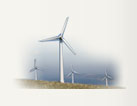Our Energy Sources
Two questions immediately strike us: Will we have enough affordable energy in the near future? What will we do for the long term?
The answers depend on our inventory of sources. Our energy supply comes mainly from fossil fuels, with nuclear power and renewable sources rounding out the mix. These sources originate mostly in our local star, the Sun. Electricity falls into its own category because it’s an energy carrier and not a primary source. Here we explore the pros and cons of each resource and look at some of the emerging technologies that could transform our energy situation in the future.

Most of the energy we capture for use on Earth originates in the nuclear reactions powering our Sun.
In addition to direct solar power from photovoltaic and solar thermal sources, coal, oil, natural gas, biomass, and even the wind and hydropower we harness to generate electricity originally derive their energy content from the effects of sunlight. Learn how our local star is the ultimate energy source.
More about the sun

39% of U.S. energy from all sources is used to generate electricity.
Experts predict an 11% increase in the demand for electricity in the United States by 2040. What sources do we currently depend on to generate our electric power supply and how might they change in the future?
More about electricity

In 2015, fossil fuels provided about 81% of the energy used in the United States, including the energy to generate most of our electricity.
Fossil fuels supply the affordable energy we need for many of the functions essential to our society. Learn about the costs and benefits of each of these sources, including the environmental consequences of maintaining the status quo.
More about fossil fuels

20% of our electricity was generated by nuclear fuel in 2015.
Nuclear power provides about 9.5% of the total U.S. energy supply, emitting no greenhouse gases but producing spent-fuel waste that is radioactive and must be stored safely. What are the implications of expanding this resource?
More about nuclear

In 2015, 10% of our total energy use came from renewable energy sources, such as biomass, wind, solar, and hydropower.
Renewable sources are environmentally attractive for many reasons but today there are some notable limitations to their use. Nonetheless, experts project that during the next two decades, renewable energy will provide a growing portion of U.S. overall energy supplies.
More about renewable sources

An increasing share of future energy needs will be met by technologies now in limited use or still in the research or development phase.
Public and private research into technologies that could improve—or even completely change—our energy situation has been active for years. Learn about a few of our options, the problems they address, and the obstacles to their implementation.
More about emerging technologies
